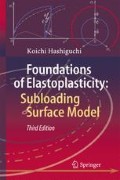Abstract
Thermodynamic laws must be satisfied in all natural phenomena, while, needless to say, an elastoplastic constitutive equation is not also an exception.
Access this chapter
Tax calculation will be finalised at checkout
Purchases are for personal use only
References
Armstrong PJ, Frederick CO (1966) A mathematical representation of the multiaxial Bauschinger effect. CEGB report RD/B/N 731 (or in materials at high temperature) 24:1–26
Bartel T, Menzel A, Svendsen B (2011) Thermodynamic and relaxation-based modeling of the interaction between martensitic phase transformations and plasticity. J Mech Phys Solids 59:1004–1019
Belytschko T, Liu WK, Moran B (2014) Nonlinear finite elements for continua and structures, 2nd edn. Wiley, New York
de Souza Neto EA, Perić D, Owen DJR (2008) Computational methods for plasticity. Wiley, Chichester
Dettmer W, Reese S (2004) On the theoretical and numerical modelling of Armstrong-Frederic kinematic hardening in the finite strain regime. Compt Meth Appl Mech Eng 193:87–116
Fung YC (1965) Foundations of solid mechanics. Prentice-Hall, Englewood Cliffs
Germain P, Nguyen QS, Suquet P (1983) Continuum thermodynamics. J Appl Mech 50:1010–1020
Hashiguchi K (2001) On the thermomechanical approach to the formulation of plastic constitutive equations. Soils Found 41(4):89–94
Haupt P (2000) Continuum mechanics and theory of materials. Springer, Wien
Hill R (1948) A variational principle of maximum plastic work in classical plasticity. Quart J Mech Appl Math 1:18–28
Hill R (1950) The mathematical theory of plasticity. Oxford University Press, London
Holzapfel GA (2000) Nonlinear solid mechanics: a continuum approach for engineering. Wiley, New York
Houlsby GT, Puzrin AM (2006) Principles of hyperelasticity: an approach to plasticity theory based on thermodynamic principles. Springer, Heidelberg
Lemaitre JA (1992) A course on damage mechanics. Springer, Heidelberg
Lemaitre JA, Chaboche J-L (1990) Mechanics of solid materials. Cambridge University Press, Cambridge
Lemaitre JA, Desmoral R (2005) Engineering damage mechanics. Springer, Heidelberg
Lubarda VA (2002) Elastoplasticity Theory. CRC Press, Boca Ranton, Florida
Lubliner J (1984) A maximum-dissipation principle in generalized plasticity. Acta Mech 52:225–237
Malvern LE (1969) Introduction to the mechanics of a continuous medium. Prentice-Hall, Englewood Cliffs
Menzel A, Ekh M, Runesson K, Steinmann P (2005) A framework for multiplicative elastoplasticity with kinematic hardening coupled to anisotropic damage. Int J Plast 21:397–434
Murakami S (2012) Continuum damage mechanics: a continuum mechanics approach to the analysis of damage and fracture. Springer, Dordrecht
Onsager L (1931) Reciprocal relations in irreversible processes. I and II. Phys Rev 37 and 38:405–426 and 2265–2279
Ottosen NS, Ristinmaa M (2005) The mechanics of constitutive modeling. Elsevier, Amsterdam
Truesdell C, Noll W (1965) In: Flugge S (ed) The nonlinear field theories of mechanics, encyclopedia of physics, vol III/3. Springer, Berlin
Vladimirov IN, Pietryga MP, Reese S (2008) On the modeling of nonlinear kinematic hardening at finite strains with application to springback -comparison of time integration algorithm. Int J Numer Meth Eng 75:1–28
Vladimirov IN, Pietryga MP, Reese S (2010) Anisotroipc finite elastoplasticity with nonlinear kinematic and isotropic hardening and application to shear metal forming. Int J Plast 26:659–687
Voyiadjis GZ, Kattan PI (2006) Damage mechanics. In: Mechanical engineering, 2nd edn. CRC Press, New York
Wallin M, Ristinmaa M (2005) Deformation gradient based kinematic hardening model. Int J Plast 21:2025–2050
Wallin M, Ristinmaa M, Ottesen NS (2003) Kinematic hardening in large strain plasticity. Eur J Mech A/Solids 22:341–356
Ziegler H (1983) An introduction to thermomechanics, 2nd edn. North-Holland, Amsterdam
Author information
Authors and Affiliations
Corresponding author
Rights and permissions
Copyright information
© 2017 Springer International Publishing AG
About this chapter
Cite this chapter
Hashiguchi, K. (2017). On Formulations from Thermodynamic View-Point. In: Foundations of Elastoplasticity: Subloading Surface Model. Springer, Cham. https://doi.org/10.1007/978-3-319-48821-9_21
Download citation
DOI: https://doi.org/10.1007/978-3-319-48821-9_21
Published:
Publisher Name: Springer, Cham
Print ISBN: 978-3-319-48819-6
Online ISBN: 978-3-319-48821-9
eBook Packages: EngineeringEngineering (R0)

